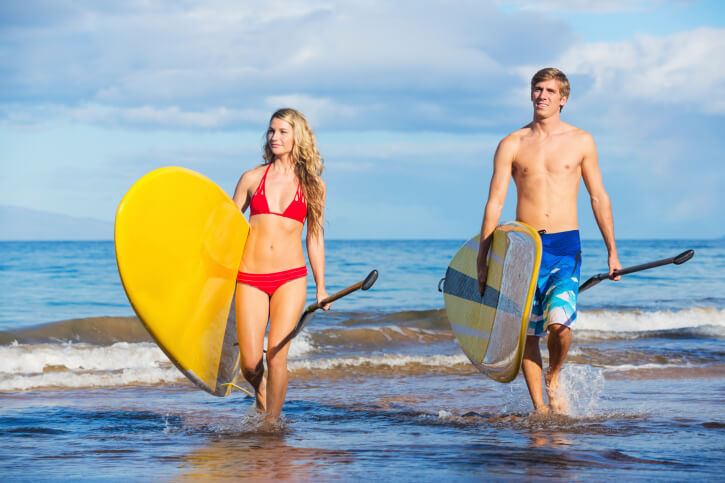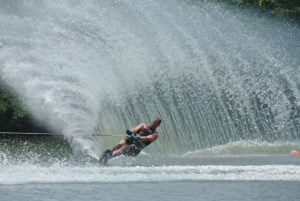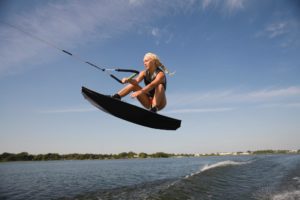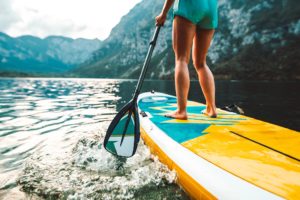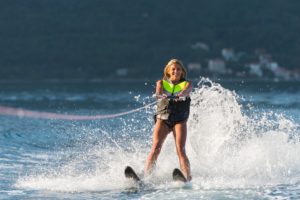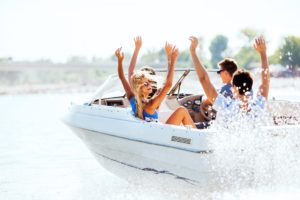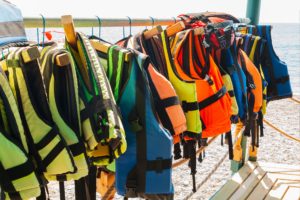Stand-up paddleboarding is a fast-growing sport that is a fun, easy way to enjoy a day on the water. It requires minimal equipment and is easy for anyone to learn. Paddleboards are very functional and can be versatile for sailing or surfing with the right equipment and setup. It may be a bit daunting for those new to this sport because there are many aspects that play a role in making the best buy. And let’s face it, paddleboards are not cheap, so you want to be sure that you find the perfect one before you make the investment. In order to help take away a little stress, below is a list of some helpful information on SUP tech, specs, board types and techniques for first-time paddleboarders.
Tech and Specs:
-
The bottom of the board is going to be a very important aspect when looking for a SUP. Flat-bottom boards are very stable and easy to balance on. However, if you are planning on racing or touring, board bottoms also come with different angles, concaves and contours to suit your needs.
-
Deck Pad: This refers to the soft surface that can be made of foam, rubber, etc. and is meant for traction, foot control and general comfort while riding.
-
Fins: These are used for control and maintaining a straight line on the water. Many boards will come with a single fin of a specified length but some may come with double, triple or integrated molded fins.
-
Handles: A useful tool for most paddle boards is the built-in handle which makes transportation much easier. Depending on the board type, these can be located in the nose, tail or along the rails of the board.
-
Rails: This refers to the sides or edges of the board. The general rule for rails is that the fuller and boxier the rails are, the harder it will be to turn but the more stability you will have.
-
Rocker: When you think of rocker, think of a rocking chair. This will make more of a difference in surfing rather than flat-water paddling.
-
Tail: The tail is the rear of the SUP. This will be important when considering how you plan on turning. With a more angular tail, turns will be more square and sharp, whereas rounder tails make for more smooth turns.
-
Paddle: Paddles for SUPs are made with an angle or “elbow” in the shaft for efficiency and performance. A paddle should be roughly 6” to 10” taller than you (this is broad because it will depend on your preference).
-
Deck Box: Some boards are equipped with a deck box which makes them compatible with sailing. This can be a great option for those windy days and adds more versatility to your board.
-
D-Rings (Front/Rear): can be used to tie down a board or also used in conjunction with bungie cords to stow gear securely on your board.
-
Leashes: A leash is a great option for those who may have balance issues or just want that security of knowing their board won’t float away in the event of a fall.
Board Types:
-
All-around boards: These are going to be majorly for close-to-shore paddling and general recreational purposes. They will be longer, thicker and best suited for those looking for something versatile that will work well whether you wanna hit the waves or find calmer spot to practice SUP yoga.
-
Hybrids: Hybrid boards integrate features from a kayak into the paddleboard. Most include storage and hatches to hold gear and other necessary items. Because hybrids incorporate features from both the SUP and kayak, they may come equipped with seat backs, heel rests, rod holders or other accessories.
-
Racing and Touring Boards: This category is more for speed and efficiency, with longer, sleeker designs and a pointed nose (bow). They will generally be less stable, but some are still made to be versatile for recreational or cruising purposes.
Techniques: Listed are a few things to think about when using your new paddleboard.
-
Mounting your board: Stand on one side of your board near the center and hold board by the rails. You can then lift yourself onto the board in a kneeling position. Once you’ve gotten your balance and a feel for it, you can stand up. If your tip or tail are digging into the water, you should adjust accordingly to make sure your board is level for optimum riding. If you have a paddle, the only difference is that you should set it across the paddleboard and hold onto it while getting onto the board to prevent the paddle from falling overboard.
-
Stance: In order to maintain the best balance, you should stand with your feet parallel and hip-width apart. Move your weight with your hips instead of your head. Try not to stare at your feet; instead, focus on the beautiful view around you.
-
Strokes: This may seem unnecessary, but it is important to know how to paddle in order to get where you want to go. Beginners will want to keep their strokes shorter and close to the side of the board until you get more comfortable. A helpful guide to maintain a straight line is to have about 3-4 strokes on one side then switch to the other side, etc. Also, make sure to switch hand positions when switching sides.
-
Turns:
- Sidestroke: This refers to paddling on one side in order to turn a desired direction. To go right, you would paddle on the left and to go left, you would paddle on the right.
- Backpaddle: This will allow you to quickly turn or reverse direction by dragging the paddle or paddle backwards in the water on either side of the board.
- SEA “C” Stroke: If you plant your paddle in the water towards the front of the board and sweep it back through the water towards the tail, you are doing a sea or sweep stroke.
Now that you know the basics, it’s time to get out and explore the waters! Head over to our paddleboard shop to browse a wide variety of different boards and SUP accessories to keeps you safe and ready for any adventure that comes your way.
